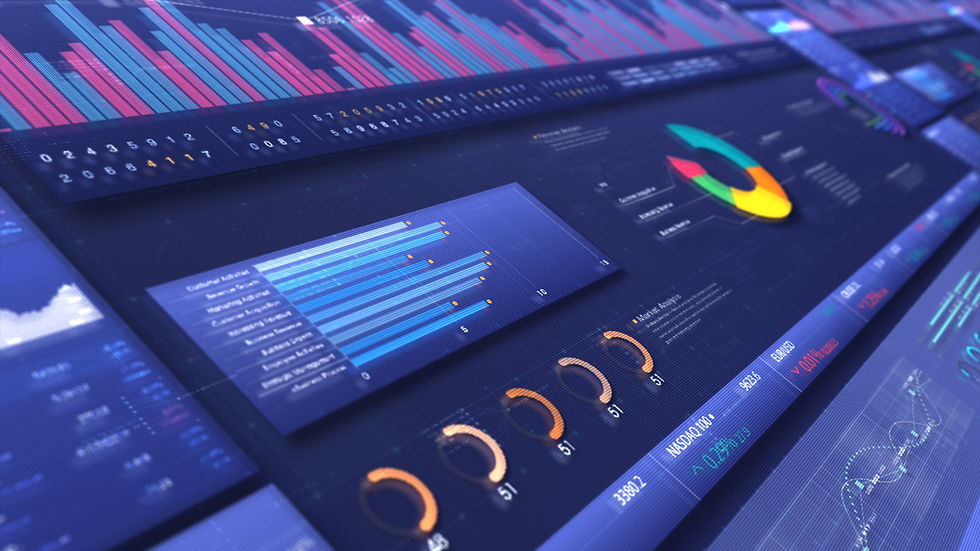Not Your Grandma’s Spreadsheet: Excel’s Most Powerful Features Today
- Christian Torres
- Sep 13, 2024
- 4 min read
Updated: Mar 27
When you hear "Excel," you might picture endless rows and columns of numbers, resembling something out of your grandma's old office. But here's the truth: Excel has come a long way since then! What was once a simple tool for balancing budgets or creating lists has evolved into a data powerhouse, offering features that can transform your analytics game.
Whether you're a small business owner, an analyst, or just someone who likes to keep life organized, Excel continues to be one of the most versatile and powerful tools out there. Let's dive into some of Excel’s Most Powerful Features Today make it more than just a spreadsheet program.

1. Power Query: Your Data’s Best Friend
Ever find yourself stuck with messy data spread across multiple sources? That's where Power Query steps in. It lets you connect, clean, and transform data from a wide range of sources like databases, web pages, or even PDFs, with just a few clicks. Gone are the days of manual copy-pasting – now you can automate your data collection process and focus on what truly matters: analyzing the results!
2. XLOOKUP: Say Goodbye to VLOOKUP’s Limitations
For years, VLOOKUP was the go-to function for finding data in large tables. But it had its quirks (like only searching from left to right). Enter XLOOKUP, a more powerful and flexible tool that allows you to search in any direction and return multiple values. Whether you’re searching a long list of products, clients, or transaction details, XLOOKUP makes it easier and faster.
3. Dynamic Arrays: More Power to Your Formulas
In the old days, creating complex formulas across multiple cells often involved dragging and dropping or creating convoluted workarounds. Thanks to Dynamic Arrays, Excel now allows a single formula to spill results into multiple cells automatically. This means no more manual adjusting – Excel does the heavy lifting for you! Whether you’re sorting, filtering, or working with ranges, Dynamic Arrays make it seamless.
4. Power Pivot: Turbo-Charge Your Data Models
If you've ever wished you could handle millions of rows of data without your system slowing to a crawl, Power Pivot is your answer. This feature enables you to build robust data models, connect multiple data sources, and create relationships between tables – all without needing external database software. With Power Pivot, Excel becomes a miniature version of an advanced analytics tool, letting you perform complex calculations and generate meaningful insights faster than ever.
5. Data Types: A New Way to Enrich Your Cells
The traditional grid of text and numbers is now much more dynamic, thanks to Data Types. With new options like Geography and Stock, you can turn simple text like “United States” or “Apple Inc.” into rich data types linked to online data sources. This feature gives you quick access to additional information like population, stock prices, or even the CEO's name, all within the familiar Excel interface.

6. Excel Online & Collaboration: Work from Anywhere
We live in a cloud-first world, and Excel has fully embraced that shift. Excel Online allows you to work from anywhere, on any device, and collaborate with your team in real-time. No more back-and-forth emails with "final_version_3.xlsx" – your whole team can work on the same document simultaneously, leaving comments, making edits, and tracking changes seamlessly.
7. AI-Powered Insights: Let Excel Do the Thinking for You
Ever wish Excel could analyze your data and tell you what’s important without spending hours crunching numbers? With Ideas, Excel’s AI-powered insights, you get automatic suggestions on trends, outliers, and patterns. Excel's machine learning algorithms work behind the scenes, giving you data-driven insights in just a few seconds. It’s like having a data analyst on call – perfect for those moments when you're short on time or want a second opinion.
8. Custom Data Visualizations: Bring Your Data to Life
Gone are the days when Excel charts were limited to basic bar or pie charts. Today, Excel's custom data visualizations let you create stunning, interactive visuals that make your data pop. With tools like Power Map for 3D data plotting and a plethora of chart types, Excel transforms raw numbers into compelling, easy-to-understand visuals that captivate your audience.
9. Integrations with Power BI: Analytics at the Next Level
While Excel is a powerful tool on its own, it now seamlessly integrates with Power BI, Microsoft's advanced business intelligence tool. This means you can take your Excel data and turn it into rich, interactive dashboards and reports, sharing them with others across your organization. Power BI’s deep analytics features, combined with Excel’s flexibility, create a perfect pair for anyone serious about data-driven decision-making.
Final Thoughts: Excel Is Just Getting Started
The belief that Excel is outdated is one of the biggest misconceptions in the business world today. While new tools emerge every day, Excel continues to innovate and adapt, integrating cutting-edge features that keep it relevant. From automating complex data processes to offering AI-driven insights, Excel proves time and time again that it’s not just a tool from the past – it’s a tool for the future.
So, the next time someone tells you Excel is just for simple spreadsheets, you can confidently say: “Not anymore.” Excel has evolved, and with its vast array of new features, it’s not going anywhere anytime soon!
About the Author
Christian Torres (The Sheet Freek) Founder of Stark Analytics & Excel Automation Expert has over 15 years of experience in developing custom Excel tools, templates, dashboards, systems, and automations for businesses.
Want an Excel Expert on Demand? Book a session with Christian and get help live.
Need help building the super-powered Excel tool of your dreams?
Connect with us today.
or check out our Solutions Page...
.png)


